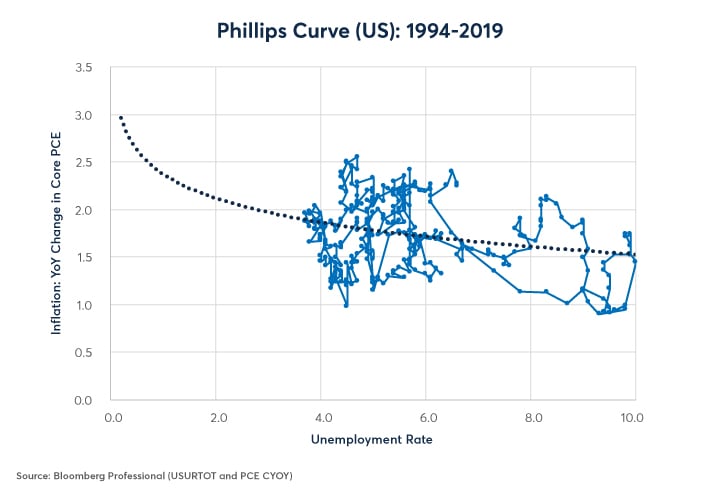
- 11 Jun 2019
- By Erik Norland
The UK and U.S. economies look similar in almost every respect except one: interest rates. The Bank of England (BoE) has short-term rates at 0.75% while the Federal Reserve (Fed) has them a 2.375% (Figure 1) Otherwise, both have exceptionally low unemployment (Figure 2), reasonably low core inflation (Figure 3) and an extremely flat Phillips curve (the Phillips curve states that inflation and unemployment have an inverse relationship) (Figures 4, 5 and 6), which imply that low unemployment is not generating inflation in either country. Neither nation has deleveraged its non-financial sector since the 2008 crisis (Figure 7) but they have delivered superior GDP growth when compared to the Eurozone (Figure 8) in large part due to the BoE and the Fed getting rates close to zero much sooner than the European Central Bank (ECB).
So why have U.S. and UK monetary policies diverged so much in recent years? The one-word answer is Brexit. The uncertainty surrounding the UK’s eventual exit from the European Union has prevented the BoE from following the Fed’s rate path higher. There is a lot of truth in this explanation as Brexit has weighed heavily on the BoE’s rate path, but it’s far from complete. The forward curves for SONIA and SOFR, the new post-ICE LIBOR, short-term interest rate benchmarks, show UK and U.S. rates partially converging by the early 2020s. On the one hand, UK markets see the BoE gradually raising rates while the U.S. interest rate market sees the Fed actively cutting rates between now and the end of 2020. Basically, investors think that the Fed made a mistake by raising rates too soon while they also believe that the BoE, given its own situation, is basically on the right path.
When it comes to the jobs market, the Fed seems to be alarmed by unemployment below 4%. Some of the Fed’s research suggests that if unemployment stays below 4.1-4.7%, U.S. inflation will begin to accelerate. Based partly on this assumption, the Fed raised rates nine times between late 2015 and the end of 2018.
Although UK unemployment is at a similar level to that in the US, the BoE has taken a much more relaxed view of the likelihood of higher inflation ahead. As the Fed actively raised rates, the BoE hiked a net of one time: cutting rates after the Brexit referendum in 2016 and then hiking once in 2017 and again in 2018. Basically, the BoE’s policy looks like a less extreme version of the ECB’s despite the UK economy more closely resembling the US than the Eurozone. Unlike the US and the UK, the Eurozone experienced a double-dip recession and unemployment still exceeds its pre-crisis levels.
The uncertainty surrounding Brexit will continue to hang over the UK economy and monetary policy until at least October this year and perhaps much longer, depending upon the outcome of the leadership race to succeed Theresa May and how successful the next Prime Minister is at navigating the relationship with Parliament and the EU. In any case, the pound, and not UK interest rate markets, will act as the primary shock absorber for Brexit: perhaps declining sharply in the event of a no-deal outcome and probably spiking higher against both the euro and the dollar in the event of a deal (or a ‘remain’ victory if there were to be a second referendum).
Essentially, the UK rate market must price two contradictory scenarios: a no-deal outcome (about a 29% probability, according to oddsmakers) or leaving with a deal/an extension/’remain’ victory in a second referendum (a combined 71% probability). In the event of a no-deal, the pound would likely plunge, and the BoE would probably cut rates, at least temporarily. Inflation would likely rise, and the pound might absorb some of the negative impact to the economy. This puts the BoE in a dilemma: lowering rates to protect growth or raising them to contain inflation. But we know from 2016 that the BoE will see any bump in inflation as temporary and will opt to contain economic damage by easing monetary policy.
Some sort of deal with the EU will likely send the pound soaring, which could cause a temporary dip in inflation. The BoE would likely look past this and continue its course of hiking rates, eventually raising them towards 1.5% – about the level that U.S. fixed income markets think that the Fed will eventually wind up at (Figure 9).
What prevents both the BoE and the Fed from hiking further is debt. Investors clearly don’t believe that the highly leveraged U.S. and UK economies can function with high levels of interest rates. Even the Fed, currently the world’s most aggressive at tightening among central banks, doesn’t foresee rates over 3%.
All examples in this report are hypothetical interpretations of situations and are used for explanation purposes only. The views in this report reflect solely those of the author(s) and not necessarily those of CME Group or its affiliated institutions. This report and the information herein should not be considered investment advice or the results of actual market experience.
About the Author
Erik Norland is Executive Director and Senior Economist of CME Group. He is responsible for generating economic analysis on global financial markets by identifying emerging trends, evaluating economic factors and forecasting their impact on CME Group and the company’s business strategy, and upon those who trade in its various markets. He is also one of CME Group’s spokespeople on global economic, financial and geopolitical conditions.
View more reports from Erik Norland, Executive Director and Senior Economist of CME Group.
Interest Rate Options
With 2.4 million contracts traded daily in 2018, and 140 expirations listed at a time across Treasuries and Eurodollars, Interest Rate options give you the liquidity and flexibility to manage risk efficiently across the entire U.S. dollar-denominated yield curve.











